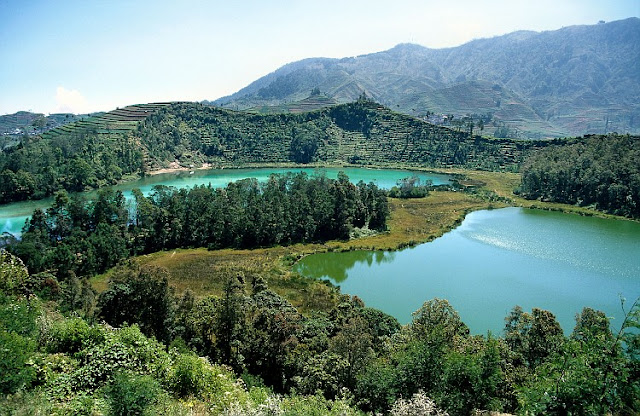Borobudur Temple Compounds
 |
| The 1,200-year-old Borobudur temple is home to hundreds of Buddhist statues. Photograph by Marcel Malherbe |
The world’s largest Buddhist monument draws pilgrims from around Southeast Asia to a remote hilltop in central Java, surrounded by lush green vegetation and ringed by volcanoes—one of which remains active.
Some 1,200 years ago builders carted two million stones from local rivers and streams and fit them tightly together without the aid of mortar to create a 95-foot-high (29-meter-high) step pyramid. More than 500 Buddha statues are perched around the temple. Its lower terraces include a balustrade that blocks out views of the outside world and replaces them with nearly 3,000 bas-relief sculptures illustrating the life and teachings of the Buddha. Together they make up the greatest assemblage of such Buddhist sculpture in the world.
Climbing Borobudur is a pilgrimage in itself, meant to be experienced physically and spiritually according to the tenets of Mahayana Buddhism. As the faithful climb upward from level to level, they are guided by the stories and wisdom of the bas-reliefs from one symbolic plane of consciousness to the next, higher level on the journey to enlightenment.
Borobudur was constructed in the eight and ninth centuries during the golden era of the Sailendra dynasty, which held sway on Java and neighboring Sumatra. This ruling clan came from South India or Indochina and helped to establish Java as a center of Buddhist scholarship and worship.
The magnificent site drew pilgrims for hundreds of years—Chinese coins and ceramics found there suggest that the practice continued until the 15th century. (In fact it has been revived today.)
But Borobudur was mysteriously abandoned by the 1500s, when the center of Javan life shifted to the East and Islam arrived on the island in the 13th and 14th centuries. Eruptions deposited volcanic ash on the site and the lush vegetation of Java took root on the largely forgotten site.
In the early 19th century Sir Thomas Stamford Raffles, British governor of Java, heard of the site and took an interest in having it excavated. While this process revealed Borobudur’s treasures it also triggered a process of decay by exposing them to the elements. Villagers liberated stones for building materials, and collectors removed Buddha heads and other treasures for private and public collections around the world.
Fortunately, the decline of Borobudur was arrested by tighter regulations and one of the most ambitious international preservation projects ever attempted. The “Save Borobudur” campaign was launched in 1968 through the government of Indonesia and UNESCO.
The massive monument’s lower terraces were dismantled and their priceless relief panels were cleaned and treated against weathering. During this process an extensive drainage system was put in place to prevent the erosion that had taken such a toll on the temple. Over eight years a million stones were removed and later reassembled.
The result is that Borobudur remains today what it was 1,200 years ago—a unique treasure to rival any site in Southeast Asia.
How to Get There
Borobudur is about 25 miles (40 kilometers) from Yogyakarta, where many day-trip tours can be booked. Those wishing to visit independently, or stay in Borobudur village outside the park entrance, can travel to the site by bus or taxi.
When to Visit
Though Borobudur teaches Buddhists to look inward, there are fantastic views from the temple over green fields and trees to distant hills and volcanoes—including active Merapi. Sunrise and sunset are particularly special times to be at the site. Weekends tend to be especially crowded.
How to Visit
Borobudur was designed to be climbed, and visitors able to follow the path of enlightenment to the top can experience the site as pilgrims did a thousand years ago. It’s well worth hiring a guide to explain the significance of statuary and the incredible bas-relief scenes along the way.



Comments